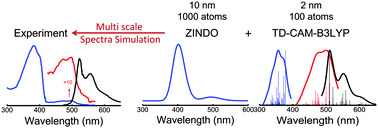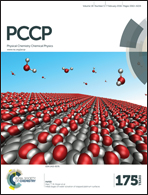Excited-state localization and energy transfer in pyrene core dendrimers with fluorene/carbazole as the dendrons and acetylene as the linkages†
Abstract
A multi-leveled theoretical investigation combining TD-DFT (B3LYP and CAM-B3LYP) methods and a semi-empirical method was conducted to determine the structure-related spectral properties of T-series dendrimers composed of nearly hundreds of atoms, based on a proposed molecular model. Both one- and two-photon absorption spectra of the dendrimer molecules were well reproduced. The “antenna effect” in the dendrimers molecule was theoretically studied. The process of excitation energy localization from chromophores in the branches to the pyrene core before the fluorescence emission was visualized using contours of the charge different density (CDD) between the electronic states. Conclusions based on the theoretical model were drawn about the observed photophysical properties of T-series dendrimers as follows: (a) increasing the generation of a branch would enhance the absorption of photons with a wavelength below 430 nm; (b) enlarging the conjugation of branches would enhance the coupling among the chromophores and would lower the excitation energy; (c) the existence of inter-molecular coupling among the “antenna” chromophores in conjugated branches and the pyrene core would significantly promote two-photon absorption.


 Please wait while we load your content...
Please wait while we load your content...